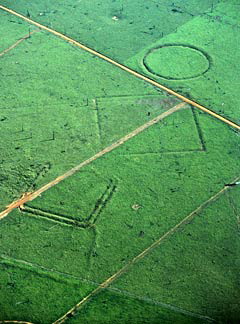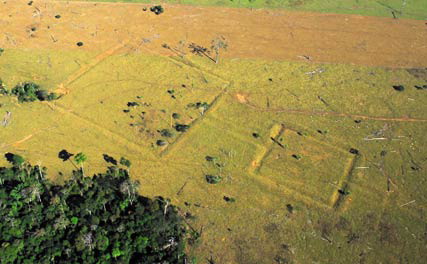|
|
|
January 8, 2010 from AOLNews Website
As a result of the deforestation of the
Amazon basin, a startling discovery has been made. Hidden from view
for centuries, the vast archaeological remains of an unknown,
ancient civilization have been found.
As Brazilian rain forest has been cleared away to make way for animal grazing, the architectural footprint of a network of ancient villages has been revealed.
David Grann, author of the book "The Lost City of Z," points out that the existence of the ruins overturns the previously held belief that this portion of the Amazon basin had always been a pristine wilderness, even though legends of a lost Amazonian city still lingered by the time the Spanish arrived on the continent.
According to Martti Parssinen, Denise Schaan and Alceu Ranzi, the authors of the study, the community likely had a population of more than 60,000 people.
The researchers said they have only uncovered roughly 10 percent of the existing structures, which may date as far back as A.D. 800.
The discovery of the ruins of an ancient civilization in the upper Amazon basin
overturns previously held beliefs that the area had
always been uninhabited.
As Grann describes in his book, British explorer Percy Harrison Fawcett claimed he had found evidence of an ancient civilization, which he called the City of Z, in the same area.
He disappeared in
the jungle on a 1925 expedition undertaken with his son and a
companion.
by David Grann January 7, 2010 from NewYorker Website
The gradual devastation of the Amazon - the felling of thousands of square miles of forest, the clear-cutting of the jungle - has produced, paradoxically, one of the greatest archeological discoveries: a vast and complex ancient civilization.
In cleared-away areas of the upper Amazon basin, researchers, using satellite imagery, have recently pinpointed a vast network of monumental earthworks, including geometrically aligned roads and structures, constructed by a hitherto unknown civilization.
According to a new report published in the journal Antiquity, the archeologist Martii Pärssinen and other scientists have documented more than two hundred and ten geometric structures, some of which may date as far back as the third century A.D.
They are spread out
over an area that spans more than two hundred and fifty kilometers,
reaching all the way from northern Bolivia to the state of Amazonia
in Brazil.
Although the early conquistadores had heard from the Indians about a fabulously rich Amazonian civilization, which they named El Dorado, the searches for it invariably ended in disaster.
Thousands were wiped out by disease and starvation.
And after a toll of death and suffering worthy of Joseph Conrad, most scholars concluded that El Dorado was no more than an illusion. Indeed, scientists believed that the merciless conditions in the jungle were simply too inhospitable to support a large population, which is a precursor to any sort of large, complex society.
The most
influential archeologist of the twentieth century,
Betty Meggers,
famously dubbed the region a “counterfeit paradise.”
Based on this and other evidence, he insisted that the Amazon once contained large populations and at least one, if not more, advanced civilizations.
Despite being dismissed and ridiculed as a crank, he set off in 1925
to find the place, which he christened the “City of Z.” He and his
party, including his twenty-one-year-old son, Jack, then vanished
forever - a fate that seemed to confirm the madness of such a quest.
In the very area where Fawcett believed he would find the City of Z, Heckenberger and his team of researchers had discovered more than twenty pre-Columbian settlements. These settlements, which were occupied roughly between 800 and 1600 A.D., included houses and moats and palisade walls. There were geometrically-aligned causeways and roads, and plazas laid out along cardinal points, from east to west.
According to Heckenberger, each cluster of settlements contained anywhere from two thousand to five thousand people, which means that the larger communities were the size of many medieval European cities.
The latest discovery proves that we are only at the outset of this archeological revolution - one that is exploding our perceptions about what the Amazon and the Americas looked like before the arrival of Christopher Columbus.
Pärssinen and the other authors of the study in Antiquity write,
The archeologists say they still don’t know if these earthworks, which are made of trenches thirty-six feet wide and ten feet deep, with adjacent walls up to three feet high, were designed for defensive purposes or for ceremonial works.
Because of the
symmetrical shape of many of the mounds and the way they slant to
the north, there is some speculation that they may have had an
astronomical purpose.
The disappearance of this still mysterious civilization correlates with the arrival of the conquistadores in the Amazon and the spread of diseases.
Alas, the discovery of this glorious
civilization is due to another tragedy - the vanishing of the once
great jungles its people inhabited.
|



